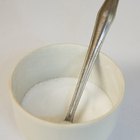
lisaaMC/iStock/Getty Images
Ordinary hams suit most occasions, but occasionally a special “country ham” enters the refrigerator for an occasion or as a gift. These special hams have a firm texture and taste thanks to a diet of peanuts and long, dry cure. Country hams may carry a covering of mold, often removed along with the hock by the butcher. They are also surprisingly salty due to the curing and smoking processes that give them their rich taste. Desalting these hams requires special treatment.
Soak the ham for 24 to 30 hours in a large kettle of tepid water. Soaking removes surface salt, occasionally visible as crystals on the skin, or rind, of the ham.
Change the water after 12 to 15 hours to remove the maximum amount of salt before proceeding. If the ham is extremely salty, change the water more frequently when a scum forms on the surface.
Remove the ham from the kettle and discard the soak. Scrub the ham with a vegetable brush under lukewarm water to remove any residual mold.
Wash and dry the kettle. Place a round cake rack or other rack that fits in the bottom to hold the ham off the bottom of the kettle. Put the kettle and ham back on the stove top burner.
Fill the kettle with cold water and bring it to a boil. Simmer the ham for approximately 20 to 30 minutes a pound until the meat is fork-tender. Skim the salty fat that rises to the top as the kettle simmers. The ham’s internal temperature should reach 150 degrees Fahrenheit.
Remove the ham from the kettle with meat forks and peel the rind back. Remove all but 1/2 inch of the fat with a fillet knife.
Score the fat diagonally, stud with cloves, add glaze and finish the ham in a roasting pan, glazed side up, in a preheated 350 degree Fahrenheit oven.
Related Articles

How to Remove a Salty Taste From Sliced ...

How to Boil Cabbage and Ham

Can You Cook a Shank Ham in Boiling ...

How to Remove the Mold From Country Ham

How to Cook a Picnic Shoulder in the ...

How to Cook a Tavern Ham

Cooking Instructions for a Ridge Creek ...

How to Cook a Ham in a Crock-Pot vs. ...

How to Carve a Spiral Cut Ham

How to Cook a Daisy Ham

How to Defrost a Bone-In Ham

How to Fully Cook a Hickory Smoked Ham

How Do I Roast a Picnic Ham?

How to Brine Pork Roast

How to Brine a Smoked Beef Brisket

How to Cook a Ham With Brown Sugar & ...

Ham Nutrition Information

How to Cook Country Ham in an Electric ...

How to Cook a Ham Leg

How to Smoke a 5-lb. Pork Roast
References
- "Joy of Cooking"; About Smoking and Brining Hams; Irma S. Rombauer, et al.; 1973
- "Joy of Cooking"; Country Hams; Irma S. Rombauer, et al.; 1973
- "Doubleday Cookbook, vol. 1"; Country Cured Hams; Jean Anderson, et al.; 1975
- "Good Houskeeping Cookbook"; Old-Fashioned Country-Cured Hams; Dorothy B. Marsh, Editor; 1942
Tips
- The traditional glaze for country hams is a thick mixture of melted brown sugar and bread crumbs.
- Avoid over-simmering the ham. It continues cooking after removal from the simmering kettle. It will only need about 45 minutes in the oven -- just long enough to crisp the glaze.
- Country hams are hung by the leg to cure and smoke. Unless you own a hacksaw and want to attempt removing the hock yourself, ask your butcher to remove it.
Writer Bio
An avid perennial gardener and old house owner, Laura Reynolds has had careers in teaching and juvenile justice. A retired municipal judgem Reynolds holds a degree in communications from Northern Illinois University. Her six children and stepchildren served as subjects of editorials during her tenure as a local newspaper editor.
Photo Credits
lisaaMC/iStock/Getty Images